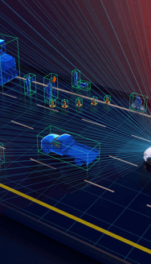Proximity sensors: measuring presence or distance
How does a proximity sensor work?
The principle of a proximity sensor is decades old, and quite simple. It is based on a coil to which a voltage is applied. This creates an electromagnetic field around the coil. If a metal object is introduced into that field, it affects the voltage through the coil: it increases to keep the field constant. The magnitude of the change detected is proportional to the distance between the object and the sensor. If a threshold value is associated with this change, it creates a switch.
Read more...When is a proximity sensor the best solution?
A proximity sensor is ideal in applications where a lot of switching is required, as it contains no mechanical parts and there is nothing to wear out. Not only does that result in a long service life, it also means the switching point never changes. If such a sensor is properly calibrated and the temperature remains constant, it will always switch at exactly the same point, no matter how often the operation is repeated.
Important points during integration
Calibrating a proximity sensor is quite a complicated task. Exactly how the electromagnetic field reacts to an object that comes within its range depends on the material the object is made of as well as its size. For example, iron has a stronger effect than aluminum.
Every proximity sensor is calibrated at the factory against a standardized DIN norm based on a standard piece of steel. However, if a different metal or an object of a different size is used, the characteristics of the sensor change. For this reason, you have to set the sensor yourself for your specific situation. That is a task for a specialist, because even the kind of aluminum used plays a role, depending on what the alloy contains. In other words, you will always have to calibrate the sensor for your application.
Influence of changes in temperature
If something does go wrong in a system that uses proximity sensors, it is often caused by a failure to take temperature changes into account. That can make a significant difference – up to 15% in terms of switching distance. Switching will then be triggered at the completely wrong time, or sometimes not at all. If you intend to export your product to a hot country, or if there are major heat sources nearby, you have to carefully check the situation and compensate for it.
Featured proximity sensors
Need some help?
Our brand-independent sensor database only lists a selection of the sensors available. There are so many different technologies and manufacturers that our online sensor database can never be 100% complete. If you can’t find what you’re looking for, or you have a question, send an e-mail to our sensor experts. We’ll gladly help you with your search.






